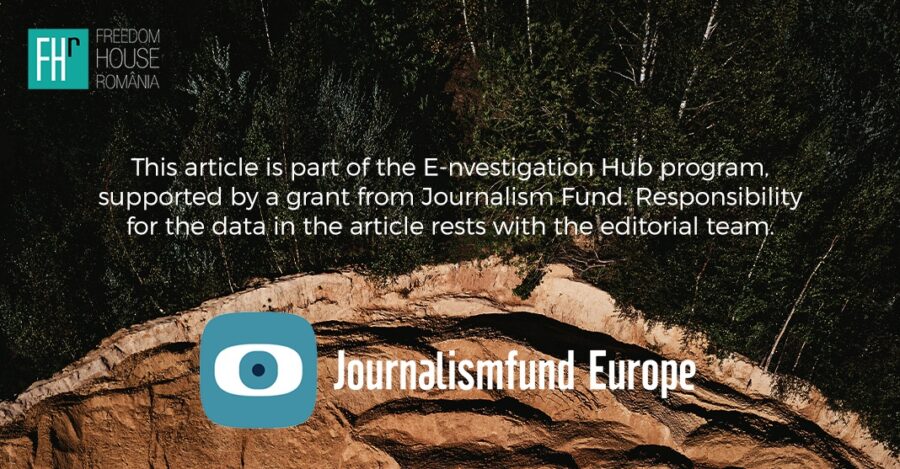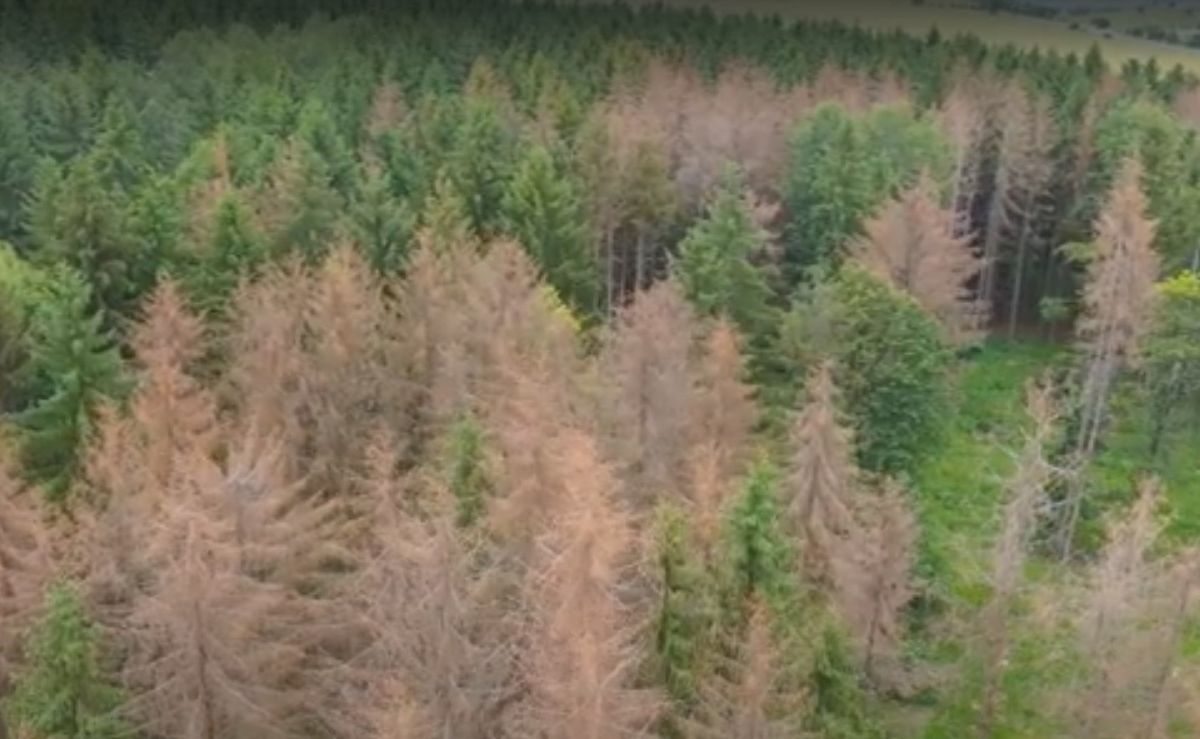The infestation with pheromone baits in a healthy forest in Moldovița, a case identified by the Suceava Forest Guard at the beginning of September, continues to draw the attention of authorities, as well as journalists and environmental activists. One of the first articles on the subject was published on PRESShub.ro, and you can read it HERE.
Two days ago, the Suceava Forest Guard once again visited the Bucovina Forest District for a thematic inspection regarding forest protection, also addressing other aspects such as the management of pheromone baits and the requests for accidental or sanitation logging (over multiple years). A report with conclusions and proposals will be formulated and sent to the National Forest Guard.
According to those at the Bucovina Forest District, the bait issue is being blown out of proportion, with more fuss being made than necessary.
From a criminal perspective, the case is being handled by the Câmpulung Moldovenesc Prosecutor’s Office, which has territorial jurisdiction over Moldovița.
To provide multiple viewpoints and an overview, we spoke with the involved parties, including the Suceava Forest Guard, the Bucovina Forest District, and environmental activist Gabriel Păun from Agent Green.
How serious is this threat compared to other illegal actions? The Moldovița case: It’s a first-degree crime!

Gabriel Păun, from Agent Green, explained to us that „the bark beetle is a regular member of the forest ecosystem and is naturally controlled. When winters are longer and colder, the larvae of these insects don’t survive in large enough numbers to affect the forest. But with climate change, they survive in increasing numbers and affect forests planted in monoculture systems. Monocultures are poor in biodiversity. They have a short food chain, and the few species that live there are extremely vulnerable. Monocultures are not functional ecosystems. They are similar to agricultural grain crops. These are areas with many trees, but they cannot be called forests.
The presence of this bark beetle in spruce forests is not a crime. Human intervention, however, is. It’s a first-degree crime (with 1 being the highest degree) both to replace resilient native forests with vulnerable spruce monocultures and to deliberately attract the bark beetle in larger numbers and more quickly by placing pheromones.”
According to Gabriel Păun, such cases have also occurred „in Sweden, a country with a premium reputation but with a rotten character. They don’t practice what they preach. They invented greenwashing and clear-cut logging. Almost the entire country is a spruce plantation that is cut down at a young age. The model was adopted by German countries, and now all of them are suffering from forest die-off, regardless of whether pheromones are used or not. Nature is trying to fix what humans have damaged, and climate change is accelerating the process, either through these bark beetles or through windthrow. The spruce forests are being felled by nature anyway. There’s no need for additional crimes through the use of pheromones. The reason Romanian criminals do this is to cut the forest before it reaches the legal harvesting age, which for spruce is 100 years, although if left alone, it could live for 300 years.
In the last 25 years, so much forest has been cut down that it’s now over 90% too young to be harvested. The last forests to be cut are the primary and old-growth ones that were previously inaccessible, and now roads are being built to cut them too. On the other hand, in younger forests, reasons for cutting are being fabricated to allow logging at 40-60 years of age. The desperation is so great that criminals no longer wait for the beetle to intervene naturally, and they place these pheromones to induce mass die-offs and justify clear-cutting.”
Nete Ovidiu, from the Bucovina Forest District, believes the fuss is bigger than what is actually happening there.
Nete Ovidiu – Bucovina Forest District: „The Suceava Forest Guard is currently conducting inspections, requests have been made for sanitation logging to combat beetle infestations. The landowner makes the request, our boys go into the field and mark the trees to be removed, and then it is sent to the Guard. This whole process takes two or three months. If the Guard orders the cutting, you’re fine; if not, the cutting doesn’t happen. Those pheromone baits are a kind of smokescreen, because they are only effective for three days after opening the packet. I think the fuss is bigger than what’s really happening there.”
The Suceava Forest Guard is currently conducting a thematic inspection at the Bucovina Forest District
Pavel Rusu, Head of the Forest Regime Enforcement and Timber Traceability Control Service, stated that a thematic inspection regarding forest protection was initiated, precisely in response to what happened, and we began the inspection two days ago. According to him, “we conducted another inspection at the same landowner before, but it was only partial as we couldn’t verify everything, and we didn’t find the same problems as now. However, this time we’ve expanded the inspection to the entire forest district. It’s more difficult because the area is highly fragmented, spanning multiple administrative units. And that’s an issue because approvals take time, and the municipalities handle the auctions for timber removal. Even though the forest district is trying to speed up the process, they still depend on them.”

One of the objectives of the inspection is “to conduct a comparative analysis over the years and to see what was harvested this year, considering the drought and other factors, to better understand the phenomenon.” We were surprised (regarding the situation with the pheromone baits) that only the forest district knew the entire procedure, they knew the land would be inspected, meaning no one was doing it from the office. There is an ongoing criminal investigation, and we will see what the outcome is. We want to determine who bought the baits, from where, and how they were procured. The case is with the Câmpulung Moldovenesc Prosecutor’s Office, which has territorial jurisdiction there.
How can the infestation of a forest be controlled?
In the discussion with Gabriel Păun, we wondered if and how the infestation of a forest can be controlled.
He explained that this can only be done by nature. “Humans are only capable of clear-cutting to stop the attack. It’s like having a city with a few sick people and killing them all to get rid of the disease. Then you repopulate the city with people from elsewhere, but the conditions that caused the disease remain, and it will return with each generation. The same goes for forests in monoculture systems. They will be clear-cut every 50 years. They will even use fertilizers to grow faster, in order to yield a larger wood harvest in less time,” says Gabriel Păun.
‘I have visited areas on the planet where people understood that monocultures were a mistake and learned from them. They allowed the bark beetles (Ipidae) to coexist with the spruce monoculture they had planted, but not completely. A few trees survived. People waited 10 years to see what nature would do on its own. How does it heal? The surprise came. Among the trunks of the naturally fallen spruces, which began to turn into humus and enrich the soil, not only a few spruce seedlings grew, but also oak, beech, sycamore, rowan, elm, hornbeam, and ash. Where did they come from? Well, they were always there, but there was no room for them to grow because of the spruce plantation. Their seeds and seedlings had always been there, waiting for humans to learn. Birds and mammals also inadvertently carry and spread seeds, and order was restored. The forest is now a natural, rich, resilient ecosystem that is functional again. Nature healed itself.
Humans observed and learned. Now, they only selectively cut down a tree here and there so that the natural structure is preserved. Ironically, because there are no maintenance costs (since nature does everything on its own), profits are higher, and the wood is of better quality,’ claims Gabriel Păun from Agent Green.
The use of technology to support nature, a very interesting research project
According to WWF-Romania (World Wildlife Fund), attacks by bark beetles primarily occur after windfalls, windbreaks, heavy snow, freezing rain, and prolonged droughts. For this reason, they have initiated a project aimed at detecting bark beetle attacks early, starting from the moment when the trees are still green and the effects of the beetles’ actions are not yet visible to the naked eye.
As part of the project, the University of Agricultural Sciences and Veterinary Medicine Cluj-Napoca has conducted a series of studies on the possibilities for early detection (in the green) of attacks by bark beetles using remote sensing techniques and GIS, which utilize UAS (drone) systems equipped with multispectral sensors, and adapting working methodologies to the specifics of Romania’s forests.

“Together with the Faculty of Forestry in Cluj, we conducted research in a pilot area in Valea Ierii commune, Cluj County, in a forest managed by the Muntele Mare Forest District. We monitored bark beetle attacks both on the ground and with a drone that collected multispectral images. The study, conducted from April to September, will be presented this month during meetings with stakeholders in Cluj-Napoca and Baia Mare,” stated WWF-Romania.
“This is a pilot project. We are still in the calibration phase. The results of the research depend on the sensors’ ability to detect as many wavelengths from the electromagnetic spectrum as possible. This way, we will be able to evaluate whether we can apply this early detection of bark beetle attacks on a large scale or if we need to change the working protocols for further calibrations.”
Călin Ardelean, biological expert at WWF-Romania (World Wildlife Fund)
What do the forests in Suceava County look like on Global Forest Watch?
The Suceava Forest Guard has approved, according to the official website, only in 2023, exceptions to the forest management plans for 527,806 cubic meters of wood (across the 5 counties: Suceava, Botoșani, Iași, Bacău, Neamț).
Let’s see how Suceava County looks on the Global Forest Watch deforestation monitoring site.
The loss of forest cover in Suceava County, annual dynamics.
Suceava ranks first in the country for forest cover loss from 2001 to 2023, with 65,000 hectares lost

Top 5 locations of forest loss
In conclusion, although the issue of illegal and irrational deforestation is a real concern in Romania and is recognized by the Romanian state, being included as a threat to national security, we observe that new ways of justifying illegal logging of young forests are emerging. The way authorities manage this issue is quite complicated, involving many institutions with responsibilities and regulations that are not fully enforced. The case at the Bucovina Forest District could serve as a starting point for establishing clearer procedures for the use and verification of pheromone traps. The Forest Guard needs to define more precisely how these traps are purchased, who can use and manage them, and establish a form of accountability for those who exploit them illegally.






